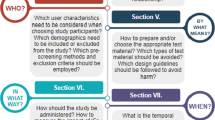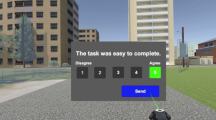Abstract
Until now the virtual assistants (like Siri, Google Now and Cortana) have primarily been confined to voice input and output only. Is there a justification for voice only confinement or can we enhance the user experience by adding a visual output? We hypothesized that providing a higher level of visual/auditory immersion would enhance the quality of user experience. In order to test this hypothesis, we first developed 4 variants of virtual assistant, each with a different audio/visual level of immersion. Developed virtual assistant systems were the following; audio only, audio and 2D visual display, audio and 3D visual display and audio and immersive 3D visual display. We developed a plan for usability testing of all 4 variants. The usability testing was conducted with 30 subjects against eight (8) dependent variables included presence, involvement, attention, reliability, dependency, easiness, satisfaction and expectations. Each subject rated these dependent variables based on a scale of 1–5, 5 being the highest value. The raw data collected from usability testing was then analyzed through several tools in order to determine the factors contributing towards the quality of experience for each of the 4 variants. The significant factors were then used develop a model that measures the quality of user experience. It was found that each variant had a different set of significant variables. Hence, in order to rate each system there is a need to develop a scale that is dependent upon the unique set of variables for the respective variant. Furthermore, it was found that variant 4 scored the highest rate for Quality of Experience (QoE). Lastly several other qualitative conclusions were also drawn from this research that will guide future work in the field of virtual assistants.










Similar content being viewed by others
References
Alben L (1996) Quality of experience: defining the criteria for effective interaction design. Interactions 3(3):11–15
Avery DR, McKay PF, Wilson DC, Volpone SD, Killham EA (2011) Does voice go flat? How tenure diminishes the impact of voice. Hum Resour Manag 50(1):147–158
Baglin J (2014) Improving your exploratory factor analysis for ordinal data: a demonstration using FACTOR. J Pract Assess Res Eval 19(5):2
Bartlett’s Test, https://en.wikipedia.org/wiki/Bartlett%27s_test. Accessed 12 Sept 2015
Branco G, Almeida L, Beires N, Gomes R (2006) Evaluation of a multimodal virtual personal assistant, 20th International Symposium on Human Factors in Telecommunication, HFT
Costello AB, Osborne JW (2005) Best practices in exploratory factor analysis: four recommendations for getting the most from your analysis. J Pract Assess Res Eval 10(7)
Ebrahimi T (2001) Quality of experience: a new look into quality and its impact in future personal communications
Fogg BJ, Tseng H (1999) The elements of computer credibility. In Proceedings of the SIGCHI conference on Human Factors in Computing Systems. ACM, p 80–87
Follmer S, Leithinger D, Olwal A, Hogge A, Ishii H (2013) inFORM: dynamic physical affordances and constraints through shape and object actuation. InProceedings of the 26th annual ACM symposium on User interface software and technology(UIST ‘13). ACM, New York, NY, USA, p 417–426
Forlizzi J, Battarbee K. Understanding experience in interactive systems. In Proceedings of the 5th conference on designing interactive systems: processes, practices, methods, and techniques. ACM, p 261–268
Freedman DA, Pisani R, Purves R (2007) Statistics, 4th edn. W.W. Norton & Company. ISBN 978–0–393-92972-0
Gebhardt S, Pick S, Oster T, Hentschel B, Kuhlen T (2014) An evaluation of a smart-phone-based menu system for immersive virtual environments. In IEEE Symposium on 3D User Interfaces 2014, 3DUI 2014 - Proceedings, p 31–34
Hamam A, El Saddik A, Alja’am J (2014) A quality of experience model for haptic virtual environments. ACM Trans Multimed Comput Commun Appl 10(3), Article 28
http://www.voxiebox.com/. Accessed 11 Sept 2015
Johnston M et al. (2014) MVA: the multimodal virtual assistant. In Proc. SIGDIAL Conference, p 257–259
Jung Y, Kuijper A, Fellner D, Kipp M, Miksatko J, Gratch J, Thalmann D (2011) Believable virtual characters in human-computer dialogs. Eurographics 2011 - State of The Art Report, p 75–100
Kazap Z, Magnenat-Thalmann N (2007) Intelligent virtual humans with autonomy and personality: State-of the-art. IOS Press, Intelligent Decision Technologies
Kumar D, Sachan A (2014) Bridging the gap between disabled people and new technology in interactive web application with the help of voice. 2014 International Conference on Advances in Engineering and Technology Research (ICAETR), p 1–5
Laurel B (2013) Computers as theatre. Addison-Wesley
Leithinger D, Ishii H (2010) Relief: a scalable actuated shape display. In Proceedings of the fourth international conference on Tangible, embedded, and embodied interaction. ACM, p 221–222
Lodato J (2005) Advances in voice recognition: a first-hand look at the magic of voice-recognition technology. Futurist 39:1
Nahl D, Bilal D (2007) Information and emotion: the emergent affective paradigm in information behavior research and theory. Information Today, Inc
Nickell J (2005) Secrets of the sideshows. University Press of Kentucky, Kentucky
O’connell I, Rock J (2011) Projection apparatus and method for pepper’s ghost illusion. US Patent 7(883):212
Riccardi G (2014) Towards healthcare personal agents. In Proceedings of the 2014 Workshop on Roadmapping the Future of Multimodal Interaction Research including Business Opportunities and Challenges (RFMIR ‘14). ACM, New York, NY, USA, p 53–56
Sabrowski JC (2013) Holographic technology at home
SitePal. SitePal. Oddcast Inc. http://www.sitepal.com/. Accessed 10 Sept 2015
Song Q, Shen H (2012) Intelligent voice assistant
Teixeiraa A, Hämäläinenb A, Avelarb J, Almeidaa N, Némethd G, Fegyód T, Zainkód C, Csapód T, Tóthd B, Oliveiraa A, Dias MS (2013) Speech-centric multimodal interaction for easy-to-access online services – a personal life assistant for the elderly. 5th International Conference on Software Development and Technologies for Enhancing Accessibility and Fighting Info-exclusion, DSAI
Thalmann NM, Thalmann D (2012) Virtual humans: back to the future. p 1–8. Proceedings of the 2012 Graphics Interace Conference
Vinayagamoorthy V, Gillies M, Steed A (2006) Building expression into virtual characters. Eurographics 2006: State of the Art Report
Volonte M, Babu S, Chaturvedi H, Newsome N, Ebrahimi E, Roy T, Daily SB, Fasolino T (2016) Effects of virtual human appearance fidelity on emotion contagion in affective inter-personal simulations. IEEE Trans Vis Comput Graph (99):1–1
Weiss B, Wechsung I, Kühnel C, Möller S (2015) Evaluating embodied conversational agents in multimodal interfaces. Rev Comput Cogn Sci 1:6
Whalen TE, Noel S, Stewart J (2003) Measuring the human side of virtual reality. In Proceedings of the IEEE International Symposium on Virtual Environments, Human-Computer Interfaces and Measurement Systems (VECIMS’03), p 8–12
Wohlin C, Runeson P, Höst M, Ohlsson MC, Regnell B, Wesslén A (2012) Experimentation in software engineering: an introduction. Springer
Wright P, McCarthy J (2005) The value of the novel in designing for experience. In Future interaction design. Springer, p 9–30
Wu W, Arefin A, Rivas R, Nahrstedt K, Sheppard R, Yang Z (2009) Quality of experience in distributed interactive multimedia environments: toward a theoretical framework. In Proceedings of the 17th ACM International Conference on Multimedia, p 481–490
Xu B, Yu Y (2010) A personalized assistant in 3D virtual shopping environment. 2010 2nd International Conference on Intelligent Human-Machine Systems and Cybernetics (IHMSC), p 266–269
Yagi A, Imura M, Kuroda Y, Oshiro O (2011) 360-degree fog projection interactive display. In SIGGRAPH Asia 2011 Emerging Technologies. ACM, p 19
Acknowledgments
Permission to make digital or hardcopies of part or all of this work for personal or classroom use is granted without fee provided that copies are not made or distributed for profit or commercial advantage and that copies show this notice on the first page or initial screen of a display along with the full citation. Copyrights for components of this work owned by others than ACM must be honored. Abstracting with credits permitted. To copy otherwise, to republish, to post on servers, to redistribute to lists, or to use any component of this work in other works requires prior specific permission and/or a fee. Permissions may be requested from Publications Dept., ACM, Inc., 2 Penn Plaza, Suite 701, New York, NY 10121-0701 USA, fax +1 (212) 869-0481, or permissions@acm.org.
Author information
Authors and Affiliations
Corresponding author
Rights and permissions
About this article
Cite this article
Saad, U., Afzal, U., El-Issawi, A. et al. A model to measure QoE for virtual personal assistant. Multimed Tools Appl 76, 12517–12537 (2017). https://doi.org/10.1007/s11042-016-3650-5
Received:
Revised:
Accepted:
Published:
Issue Date:
DOI: https://doi.org/10.1007/s11042-016-3650-5




